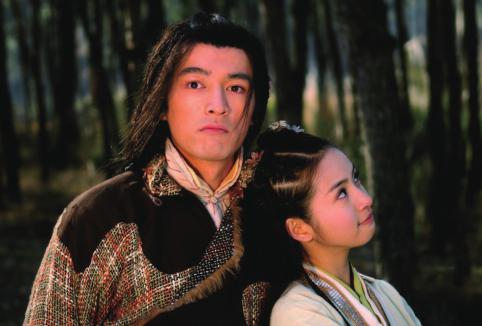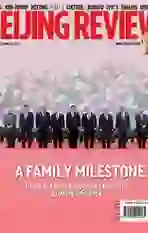A Legend Is Born
2018-07-03ByPanXiaoqiao
By Pan Xiaoqiao



‘The Chinese The Lord of the Rings— now in English for the fi rst time.” “The series every Chinese reader has been enjoying for decades!”
This is how A Hero Born, the fi rst volume of the English edition of the Chinese martial arts masterpiece Legends of the Condor Heroes, is being appraised on Amazons website. Since its release in February, A Hero Born has been republished seven times to satisfy the unprecedented demand from English-language readers.
The book, translated by Anna Holmwood, a professional translator and literary agent in the UK, received a four-star rating on Amazon. In the UK, it has an average rating of 4.2 stars, with 53 percent of the readers giving it five out of fi ve. So far, the rights to the books publication have been sold to seven countries including the United States, where A Hero Born will be released in 2019.
On the publishers website a user by the name of Nathaniel Gardner-Blatch gave a top rating of five stars to the book, describing the novel as mesmeric and a fantasy of the highest quality. “[Jin Yongs] fantasy worlds rival J.R.R. Tolkiens every bit in creativity, breadth, and depth,” writes Paul French, author of Midnight in Peking, also on the site.
Legends of the Condor Heroes is one of 15 martial-arts novels, known as wuxia novels in Chinese, by Jin Yong, the pen name of 94-yearold Louis Cha, the best-selling Chinese author alive today. Jin Yong has sold 300 million copies of his works across the Chinese-speaking world, not including electronic and digital versions of his books. Multiple spin-off fi lms, television series, comics and games have emerged from his original 15 novels written between 1955 and 1973.
Legends of the Condor Heroes itself has been adapted and remade into numerous TV series, the most recent broadcast in 2017, still able to attract a huge viewership 30 years after the storys television version produced by Hong Kong-based Television Broadcasts Limited (TVB) was introduced to Chinas mainland audiences in the early 1980s.
Jin Yongs reach even extends beyond the entertainment industry. In 1995 a Jin Yong wuxia research course was established at Peking University and since 2007, a chapter from another of his novels Fox Volant of the Snowy Mountain has been included in middle school Chinese language textbooks nationwide.
An eager readership
Chinese martial arts have long been regarded as an important symbol of Chinese culture, and are one of the most popular cultural exports from China to the West. However, this is mainly delivered through cinema, and awareness of wuxia fi ction, is far more limited. Jin Yong himself also remains relatively unknown among Western readers, despite being awarded an OBE by Queen Elizabeth II in 1981 and receiving two doctorates (one honorary and one for research) from Cambridge University. Even translator Holmwood said that she felt it was unfortunate that she had to rely on The Lord of the Rings to pitch Legends of the Condor Heroes to the publisher, speaking in Beijing in late May at this years StoryDrive Conference, an all-media platform in Asia dedicated to exploring new forms of collaboration and business models across media boundaries.
Jin Yongs wuxia novels have been translat- ed into English before—by university publishers in Hong Kong for the purpose of academic research—but these were expensive to buy and quickly out of print. Legends of the Condor Heroes is thus the fi rst of Jin Yongs wuxia novels to be produced by a commercial publisher in an English, trade paperback edition for general distribution.
In order to persuade publishers to take up her idea, Holmwood prepared a sample translation of 10,000 words, and provided basic information about the book to pique the panelsinterest before calling on the status of Jin Yong wuxia novels among Chinese-language readers to justify its potential appeal to Western readers. Finally, British publisher MacLehose Press took on the book, with plans to publish a 12-volume Legends of the Condor Heroes series.
Although the story was first published in Chinese in 1957, Holmwood believes now is the right time in both China and the West for the books English release. “Contact between China and the West has been deepening since Chinas opening up began in the late 1970s. This started mainly with political and economic contact. Cultural contact came only in the last 15 to 20 years. It does not mean that Westerners had not been interested in China until that point, but maybe there was a lack of [linguistic] competence,” said Holmwood. “Now its quite common to encounter Westerners speaking fl uent Mandarin, but that is not that long given that Jin Yong had his first books published 60 years ago. Meanwhile, at that time, there was no network of people able to translate and publish these works in English.”
Holmwood also believes that the advent of the Internet has played its part by making it easier than ever before to fi nd an audience for Jin Yongs stories in English, while it is also easier for these enthusiasts to fi nd wuxia books online.
Bridging the gap
Despite the frequent comparisons, unlike The Lord of the Rings, there is no magic or fantasy world in Jin Yongs novels. Instead, they are a swashbuckling blend of history and heroic fiction.
Legends of the Condor Heroes is set in China in the 13th century. It tells of an empire established by Han nobles, the Southern Song Dynasty (1127-1279), on the brink of collapse after three generations of rule by enfeebled emperors. Attacks by the Jurchen ethnic group living in the north, exacerbated by deceptive allies within the empire, abet the demise of an ailing dynasty. Martial artists like Guo Jing, the hero of the novel who is a Han man but raised on the Mongol territory, emerge to fight for the future of the empire. The swordsmen and warriors who fi ght alongside him are all kungfu masters. They fl y from this tree to that and walk on walls by controlling their breath and muscles after long-term kungfu practice instead of with the assistance of magic powers, which is the most attractive and mysterious element to Western readers.
Another important part of the novels is the Mongol aspect, with Genghis Khan one of the series major characters.
“In a way, the Mongols being included in the story kind of acts like a gateway for Western people into the Chinese setting and this historical background,” Holmwood said. This relatable element was also a factor in the choice of Legends of the Condor Heroes as her first exploration into the wealth of Jin Yongs work.
“There has been one very common reaction by Chinese people when I tell them Im translating Jin Yong: ‘Can Westerners really understand Jin Yongs books?” said Holmwood. “I think many Chinese consider Jin Yongs books impossible to translate.”
But according to her the human condition and emotions there within are familiar to both Eastern and Western audiences. Guo Jings story of divided loyalty between two peoples (Han and Mongol) is universal, and the narratives of love, allegiance, honor and the power of the individual against corrupt governments and invading forces is as universal as any story could be.
Holmwood believes there is already a basis for Jin Yongs works to be well-received in the West. “Wuxia fi ction is unique to China and East Asia as a whole, but it also has elements in common with modern fantasy and epic historical romance which have been popular in the West since at least the 18th century. Not only that, martial arts fi lms also have considerable success in the West,” she said at the conference.
Lost in translation
Despite being a professional translator focused on Chinese-English literature, Holmwood knew that translating a martial arts epic with a massive following like Legends of the Condor Heroes would come with a huge amount of pressure. Yet she anticipated the controversies and criticisms that would arise even before the novel was published. After many years learning history and Chinese, Holmwood later lived in China for several years. She has a great passion for ancient Chinese poems and verse, and prior to her work on Jin Yongs novel, she had already translated Under the Hawthorn Tree, based on a true story during the “cultural revolution” (1966-76), and many other short stories. Her cultural and professional experiences prepared her for what was to come.
While the translations plaudits are many, dissatisfaction has also poured in on social media from readers who claim that much of the original meaning has been lost in translation, or that the English expressions used are too loosely connected to the original Chinese meaning. The most talked-about issues focus on character names, martial arts moves, and tra- ditional Chinese concepts. Jin Yongs stories are not only about kungfu, but touch on Chinese philosophy, religion and classical allusions, with all kinds of Chinese traditional elements found throughout the novels.
For example, the most iconic martial arts skill in the book—the 18 palm attacks to defeat dragons—originates from a Taoist classic by Lao Tze from 2,500 years ago. It is not simply an action but has a strong philosophical aspect to it as well, although critics say this is totally absent in the English version.
As for the names of characters, some simply use pinyin, like Guo Jing, Yang Kang, while others employ a combination of pinyin and lit-eral translation, such as Lotus Huang, Ironheart Yang, and Cyclone Mei. While Chinese readers may find this fusion strange, it is a method which can better deliver otherwise intangible meaning to English readers.
“Translating Jin Yong is often a daunting task because of the complexity of his language, which integrates prose and poetry and makes extensive use of four-character phrases and other Chinese idioms in order to recreate the feel of traditional Chinese vernacular novels,” Petrus Liu, an associate professor of Chinese and Comparative Literature at Boston University, once said in an interview.
Holmwood herself concedes that “there are a lot of references and things in his writing essentially impossible to convey in their wholeness in English because we simply dont have the knowledge of Chinese literature and the ability in some ways to express all that history and tradition in a completely different language.”
To go some way toward solving this problem she wrote a separate three-page prologue explaining concepts unique to Chinese culture and wuxia in a narrative voice, rather than in academic prose, so as to set the scene for Western readers. Holmwood hopes to provide her readers with the context which will help them form an image of concepts central to Chinese wuxia like jianghu and wulin which shape the kungfu world and warriors—when reading the book, even though these words are written in pinyin.
For Holmwood, translation is not just about making sure that a text is accurate or correct. Her guiding principle is to make sure readers can experience the fun and satisfaction of reading a novel in the same way native readers do, stressing the importance of flexibility in literature translation. Her primary goal is that in the future the excitement of Jin Yongs wuxia novels will encourage more people to explore the Chinese language and the culture from which it is borne.
